1. What is vegetal chitosan?
Chitosan is a natural biopolymer that is primarily derived from chitin, which is the second most abundant natural polysaccharide after cellulose. Chitin is commonly found in the exoskeletons of crustaceans like crabs, shrimps, and lobsters, as well as in the cell walls of certain fungi like mushroom, aspergillus niger.
Structure and Properties:
- Chemical Structure: Chitosan is obtained by deacetylating chitin. This process involves removing acetyl groups from chitin, resulting in a polymer that has free amine groups.
- Solubility: Unlike chitin, chitosan is soluble in acidic to neutral solutions, making it more versatile for various applications.
- Biocompatibility and Biodegradability: Chitosan is known for its excellent biocompatibility and biodegradability. It’s non-toxic and can be broken down by natural biological processes.

Chitosan, sometimes known as deacetylated chitin, is a natural polycationic linear polysaccharide derived from partial deacetylation of chitin. Chitin is the structural element in the exoskeleton of insects, crustaceans (mainly shrimps and crabs shell), and cell walls of fungi (oyster mushroom, agaricus bisprous and aspergillus niger), and also is the second most abundant natural polysaccharide after cellulose.

Chitosan, a natural polysaccharide prepared of fungal origin, is initially extracted and purified from reliable and abundant food or biotechnological fungal sources such as Agaricus bisporus or Aspergillus niger.
Chitosan is composed of glucosamine sugar units (deacetylated units) and N-acetyl-D-glucosamine units (acetylated units) interconnected by ß→(1.4) type linkages.
Uses and Applications:
- Medical and Pharmaceutical Fields: Due to its biocompatibility and non-toxic nature, chitosan is used in wound healing, drug delivery systems, and as a biomaterial in tissue engineering.
- Water Treatment: Its ability to bind with heavy metals and other contaminants makes it useful in water purification and treatment processes.
- Agriculture: As a natural biostimulant and elicitor, chitosan is used to enhance plant growth and provide resistance against pathogens.
- Food Industry: It’s used as a food additive for its antimicrobial properties, and as an edible film or coating to enhance the shelf life of perishable food products.
- Cosmetics and Personal Care: In this realm, it finds use as a thickener, moisturizer, and film-forming agent, particularly in hair and skin care products.

Chitosan has been widely used in various fields, including wine, pharmaceuticals, dietary supplement, medicine, agriculture, and food industries, due to its biocompatibility, biodegradability, and non-toxicity. In recent years, researchers have investigated the use of vegetal chitosan, which is derived from fungal or plant sources, as a sustainable alternative for use in wine applications.
Variants:
- Traditional Chitosan: Traditionally sourced from marine crustaceans.
- Vegetal Chitosan: Derived from fungal sources, offering an alternative for those seeking non-animal derived products.
In summary, chitosan’s versatility, biodegradability, and non-toxic nature make it a valuable material across various industries, from healthcare to cosmetics. Its ability to be derived from non-animal sources also makes it an appealing option for vegetarian and vegan-friendly products.
2. What are the advantages of vegetal chitosan?
Vegetal chitosan, also known as fungal chitosan or mycelium chitosan, is a type of chitosan derived from the cell walls of fungi (mushroom and aspergillu niger). It has several advantages over traditional chitosan derived from shellfish, including:

- 1. Vegan and vegetarian-friendly: Vegetal chitosan is an excellent alternative for individuals who avoid animal-based products, such as those who follow a vegan or vegetarian lifestyle.
- 2. Allergen-free: Traditional chitosan is derived from shellfish, which can cause allergic reactions in some people. Vegetal chitosan does not contain any shellfish-derived ingredients, making it an allergen-free option.
- 3. Purer: Vegetal chitosan is often considered to be purer than traditional chitosan because it is derived from a single source, whereas traditional chitosan can be contaminated with other shellfish-related substances.
- 4. Better solubility: Vegetal chitosan is more soluble than traditional chitosan, which makes it easier to incorporate into various applications such as cosmetics, pharmaceuticals, wine and food.
- 5. Improved bioavailability: Some studies have suggested that vegetal chitosan has a higher bioavailability compared to traditional chitosan, which means that it can be absorbed and utilized more effectively by the body.
Overall, vegetal chitosan offers several advantages over traditional chitosan, making it an attractive alternative for individuals and industries looking for a vegan, allergen-free, and more effective chitosan source.
3. What are the benefits of vegetal chitosan in hair care?
Vegetal chitosan is a natural biopolymer derived from the structural elements in the cell walls of fungi, making it a vegetarian alternative to traditional chitosan, which is sourced from shellfish.
Vegetal chitosan and hair are complementary because they carry opposite electrical charges – Chitosan positive and hair negative . A Clear solution that contains chitosan forms a clear, elastic film on hair, increasing its softness and mechanical strength. The material can also form a gel when added to mixtures of alcohol and water.
Chitosan acts as an antistatic thereby orotectine hair from wavine and bleaching agents. It helps to retain moisture in low humidity and to maintain hair’s style in high humidity. The material can be used in shampoos , rinses, permanent wave agents, hair colourants, styling lotions, hair sprays and hair tonics.
In hair care products, vegetal chitosan offers several benefits and functions, and its efficacy can depend on the dosage used. Here’s a detailed breakdown:

Benefits of Vegetal Chitosan in Hair Care:
- Moisture Retention: Vegetal chitosan has excellent moisture-binding properties, helping to keep hair hydrated and reducing dryness.
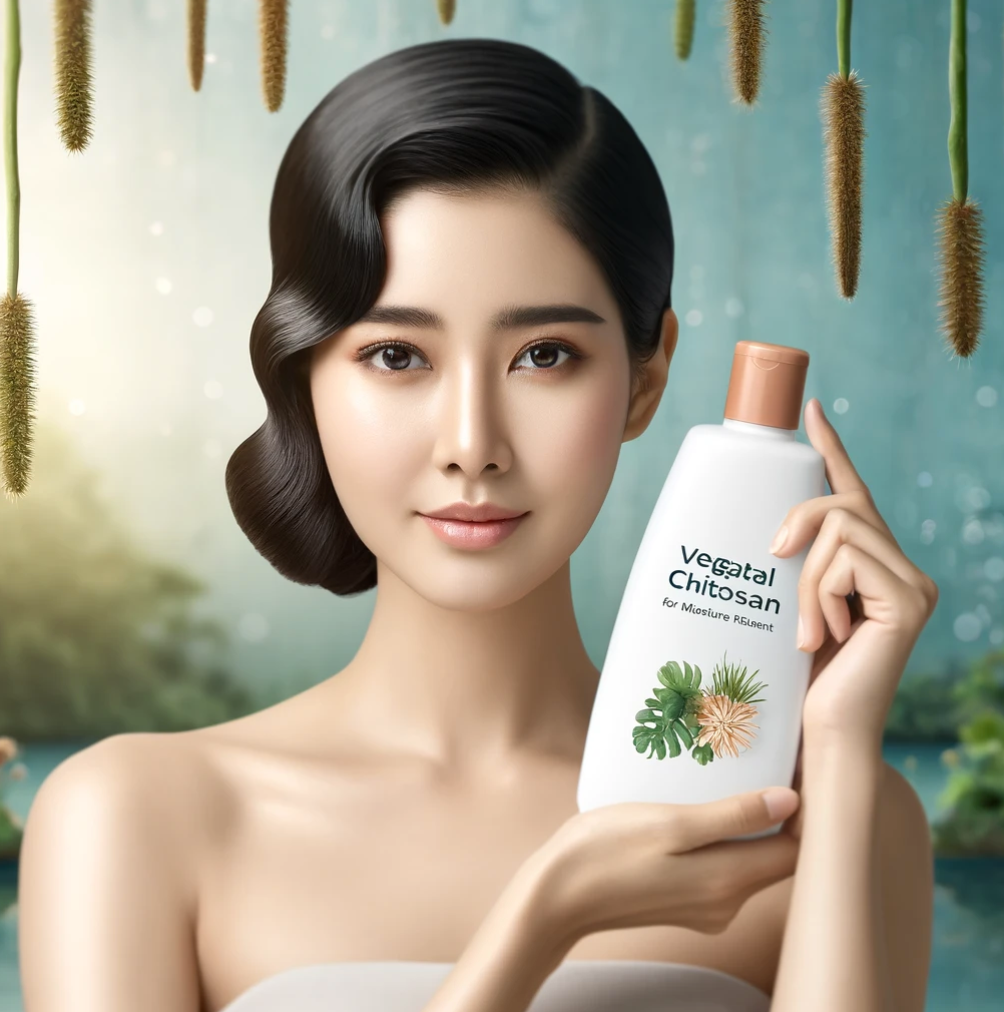
- Film Forming: It forms a breathable film over hair strands, offering protection against environmental stressors like pollution and UV rays.
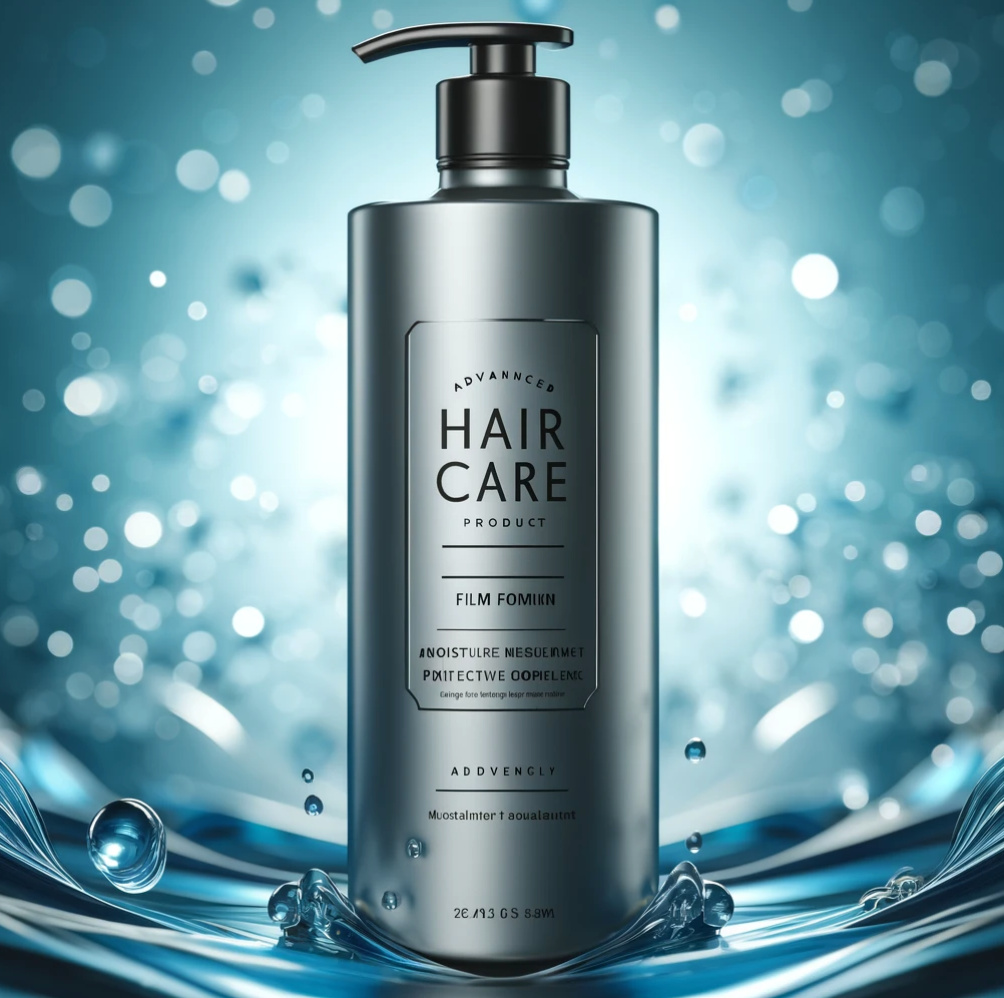
- Hair Strength and Elasticity: By reinforcing the hair cuticle, vegetal chitosan can improve hair strength and elasticity, making hair more resistant to breakage.

- Frizz Control and Detangling: Its film-forming properties can help in controlling frizz and making detangling easier, leading to smoother and more manageable hair.
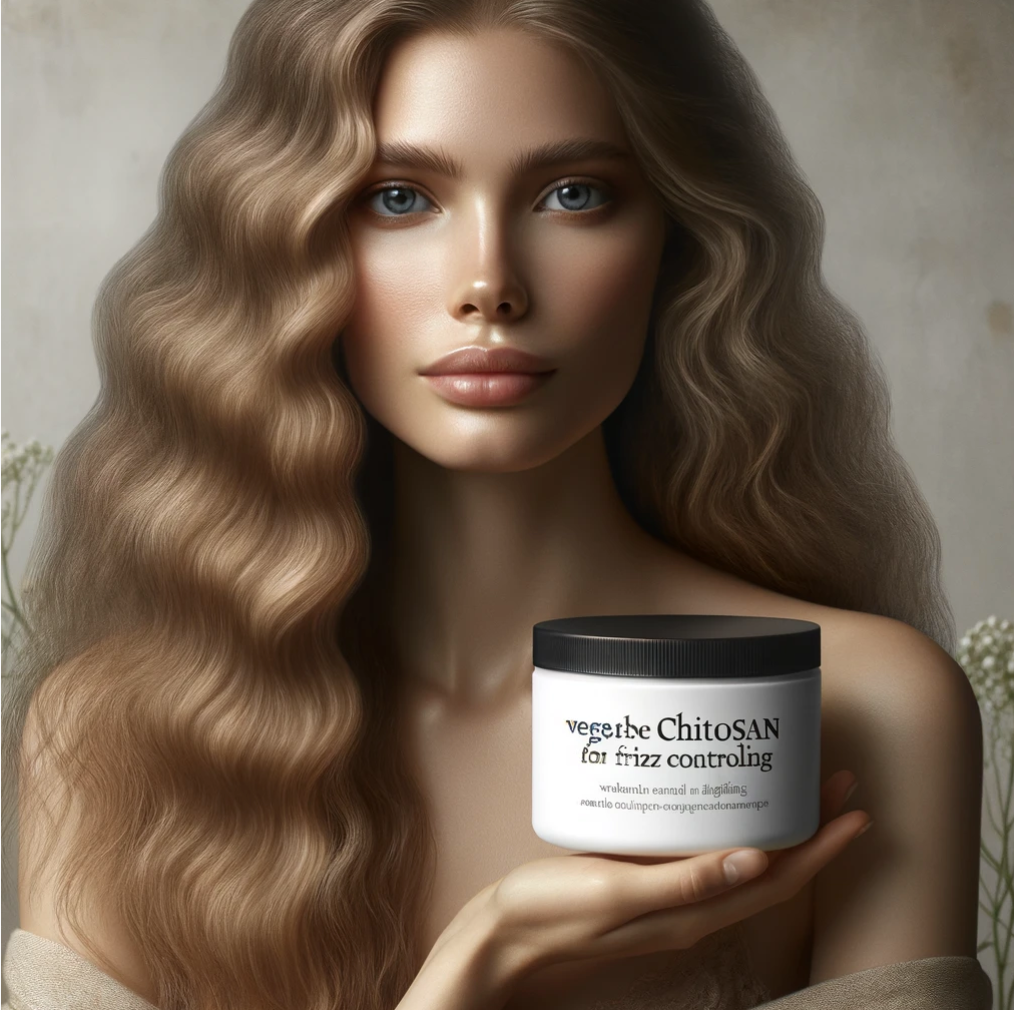
- Scalp Health: Possessing antimicrobial properties, it can contribute to a healthier scalp environment, potentially reducing issues like dandruff.
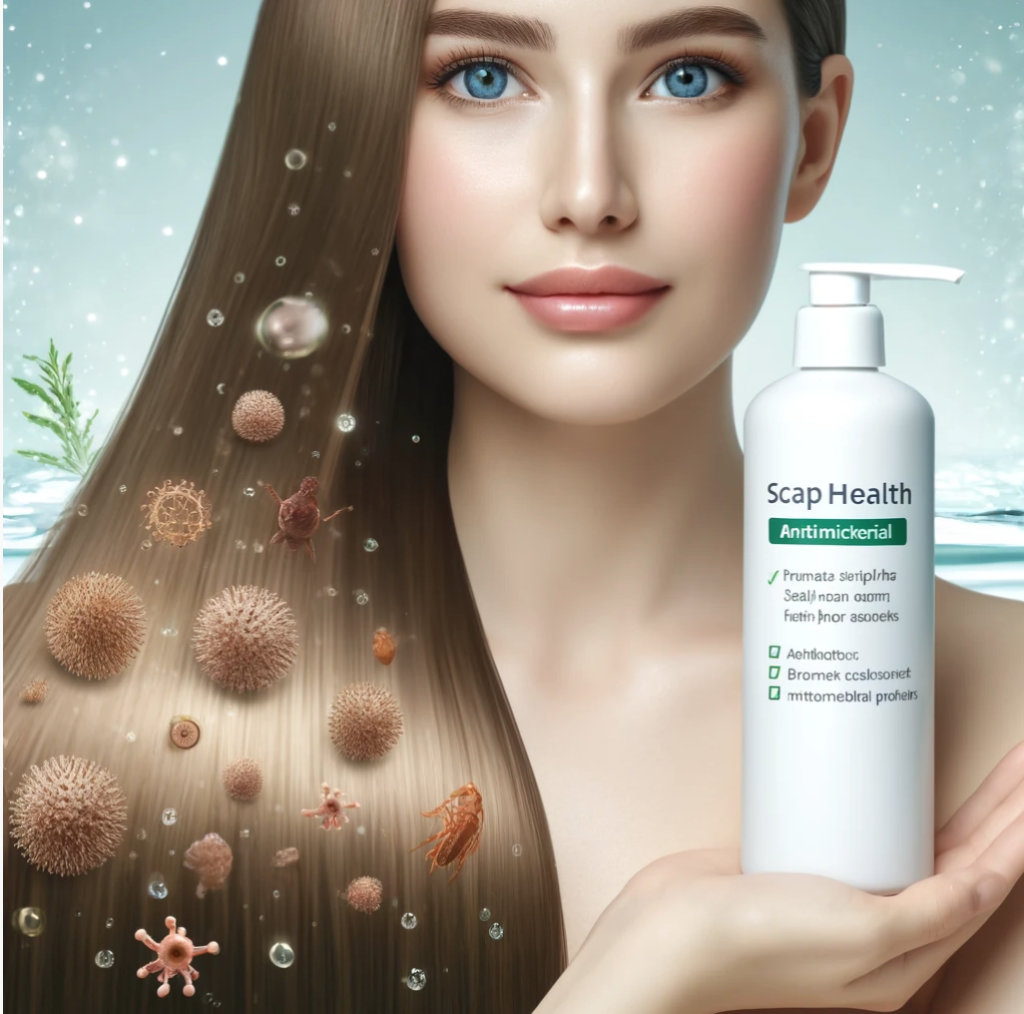
- Shine and Lustre: It can enhance the shine and lustre of hair, giving it a healthier and more vibrant appearance.

4. What are the functions of vegetal chitosan in hair care?
Functions in Hair Care Formulations:
- Thickening Agent: Vegetal chitosan can act as a natural thickener in shampoos and conditioners, improving texture and consistency.
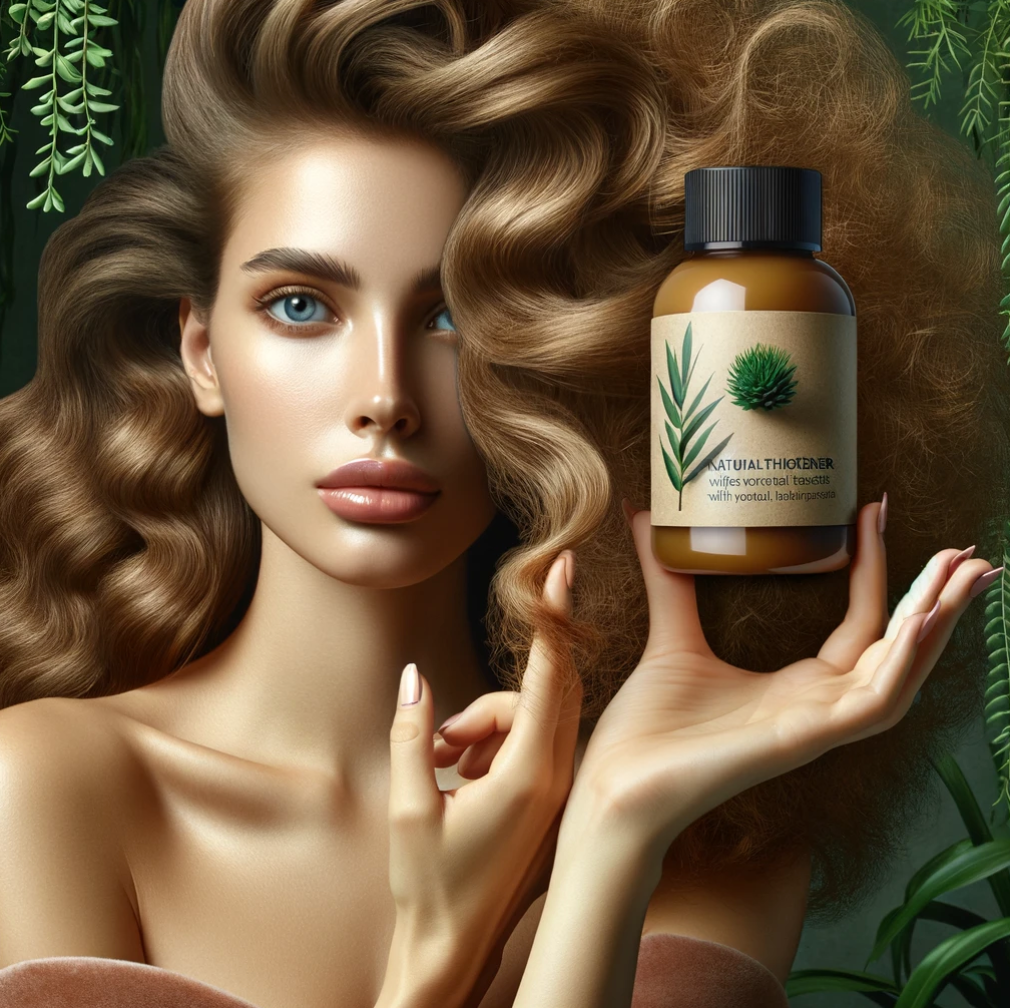
- Active Ingredient Carrier: Its ability to form films makes it an effective carrier for other active ingredients in hair care products.
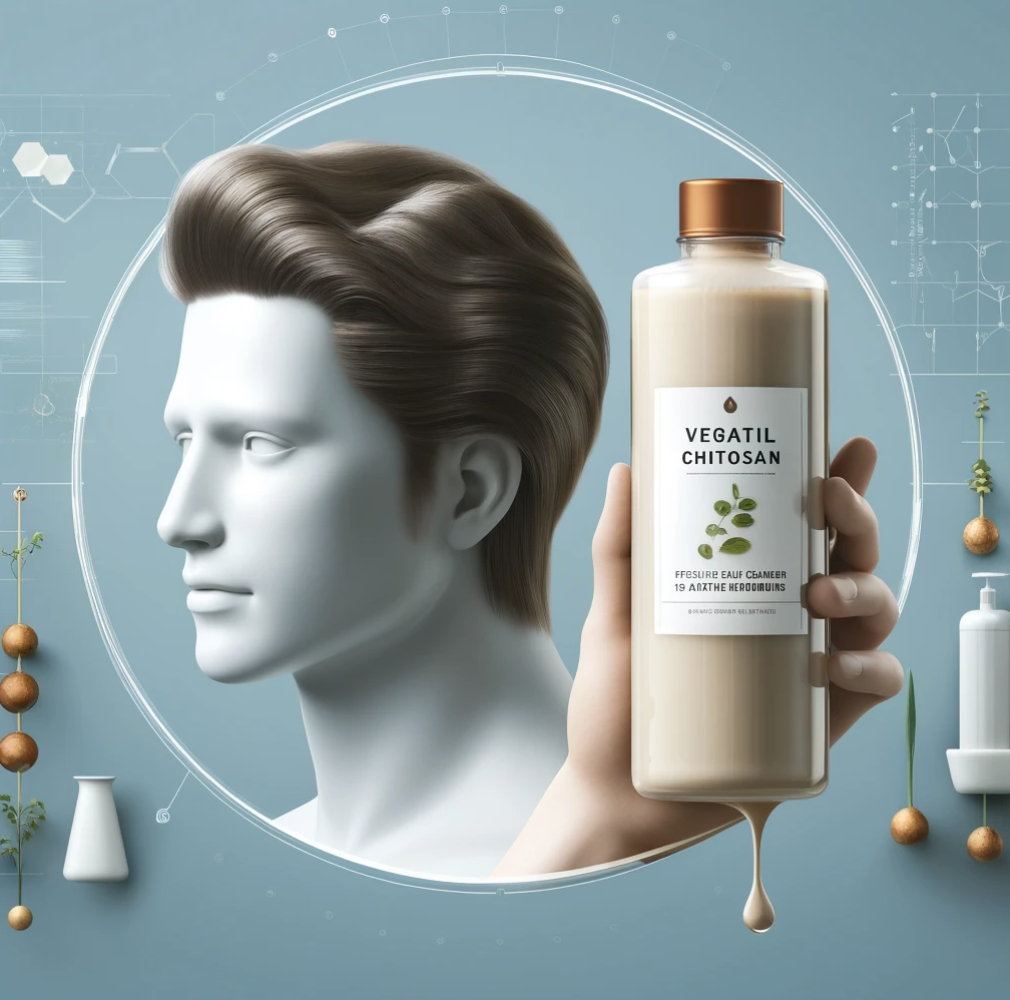
- Conditioning Agent: It contributes to the overall conditioning effect, making hair feel softer and smoother.
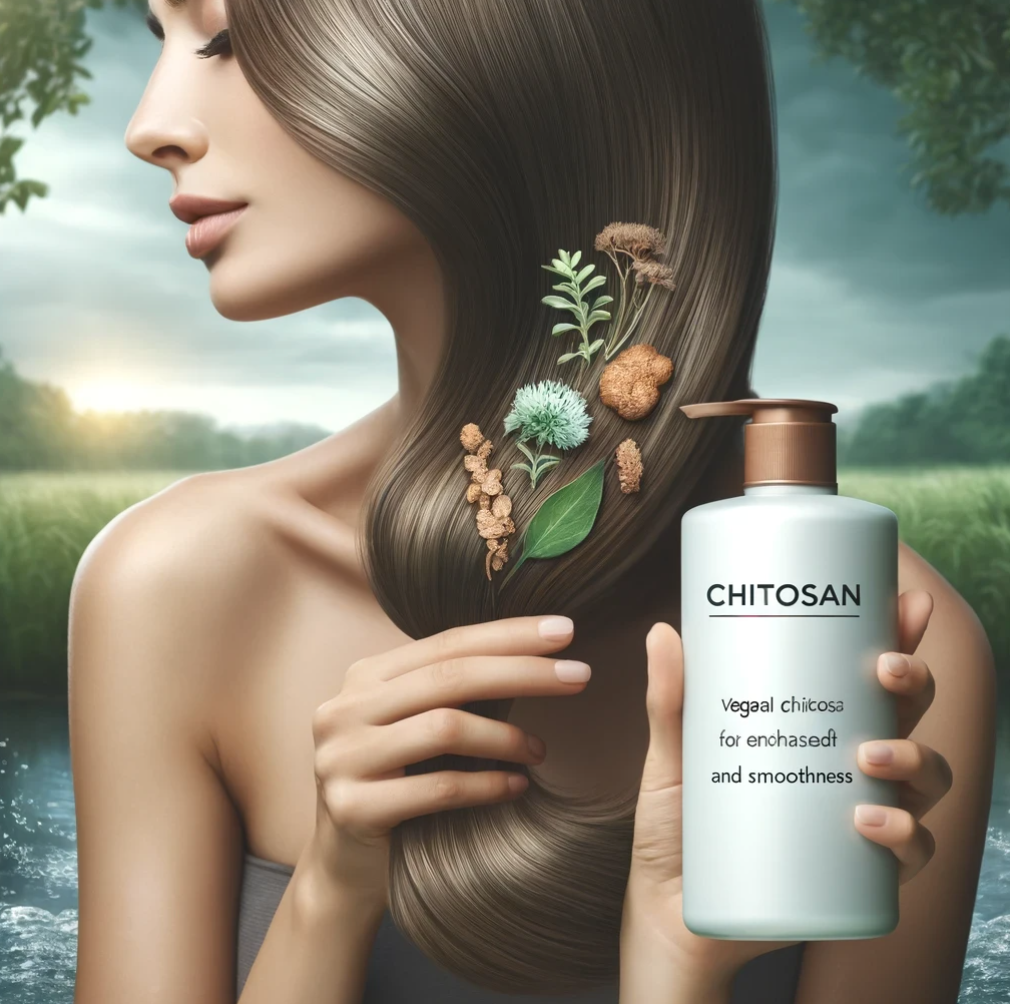
- Styling Product Component: In styling products, it can provide hold and shape to hair without the stiffness associated with synthetic polymers.

5. What are the recommended dosage of vegetal chitosan in hair care formulation?
Recommended Dosage:
- The optimal dosage of vegetal chitosan in hair care products can vary based on the desired effect and the specific product formulation.
- Typically, it is used at concentrations ranging from 0.1% to 2%.
- In shampoos and conditioners, lower concentrations (around 0.1% to 1%) are common.
- In styling products or intensive treatments, higher concentrations (up to 2%) might be used for enhanced film-forming and strengthening effects.

Professional Considerations:
- Compatibility with Other Ingredients: Formulators must consider the compatibility of vegetal chitosan with other ingredients in the product, as it may interact differently than animal-derived chitosan.
- pH Sensitivity: The efficacy of vegetal chitosan can be affected by the pH of the formulation, requiring careful adjustment during product development.
- Sustainability and Ethics: As a vegetal derivative, it is a more sustainable and ethical option compared to marine-sourced chitosan, aligning with the growing consumer demand for cruelty-free and sustainable products.
In conclusion, vegetal chitosan offers multifaceted benefits in hair care, acting as a moisturizer, protectant, and conditioner. Its natural origin and biocompatibility make it an increasingly popular choice in both consumer and professional hair care formulations. The precise dosage and application depend on the specific product goals and formulation requirements.
6. What is the flowchart of vegetal chitosan processing?
The production process of plant chitosan is mainly obtained by extracting raw materials (mushrooms, Aspergillus niger), deproteinizing with dilute acid or alkali, deacetylating, drying, etc.
Here is a simplified flowchart of the production process of vegetal chitosan for your reference.
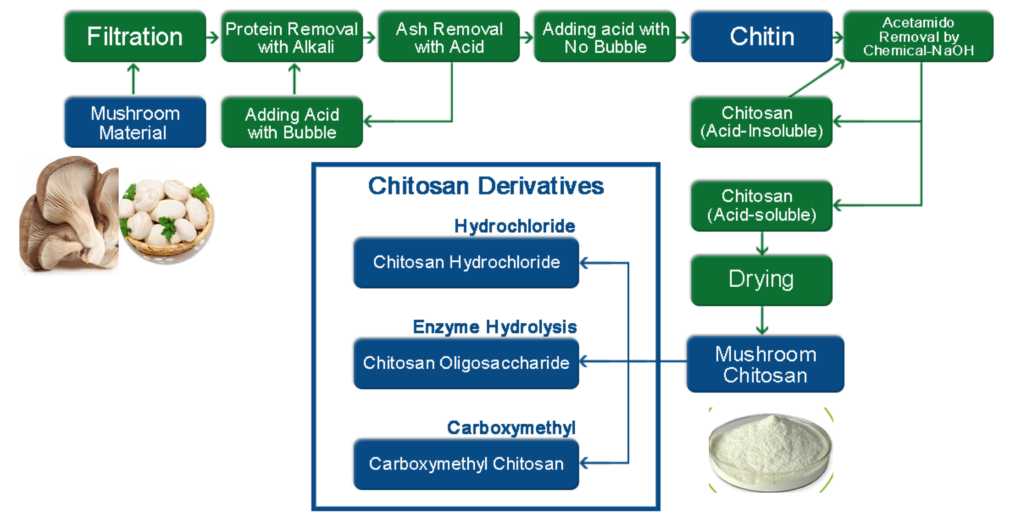
The flowchart of mushroom chitosan illustrates the process of producing chitosan and its derivatives from mushroom material. Here’s a summary of the key content:
- Starting Material: The process begins with mushroom material as the source.
- Filtration: The mushroom material undergoes a filtration process.
- Protein Removal: Proteins are then removed from the filtered material using an alkali solution.
- Ash Removal: Ash content is subsequently removed with acid.
- Chitin Extraction:
- Acid is added without bubbles to proceed to the next stage.
- Chitin is extracted, which is not soluble in acid.
- An acetylation step removes the acetyl groups from the chitin using sodium hydroxide (NaOH), converting it into chitosan, which is soluble in acid.
- Drying: The acid-soluble chitosan is then dried to produce the final mushroom chitosan product, showcased as a white powder.
- Chitosan Derivatives: Parallel to the drying process, there is a branch leading to the production of various chitosan derivatives:
- Chitosan Hydrochloride: Chitosan converted into its hydrochloride form.
- Enzyme Hydrolysis: Produces chitosan oligosaccharide through enzymatic hydrolysis.
- Carboxymethyl Chitosan: Derived through the carboxymethylation of chitosan.
The flowchart depicts a methodical approach to converting mushroom material into various forms of chitosan, focusing on the purification and chemical modification steps necessary to achieve different chitosan-based products for use in various applications.
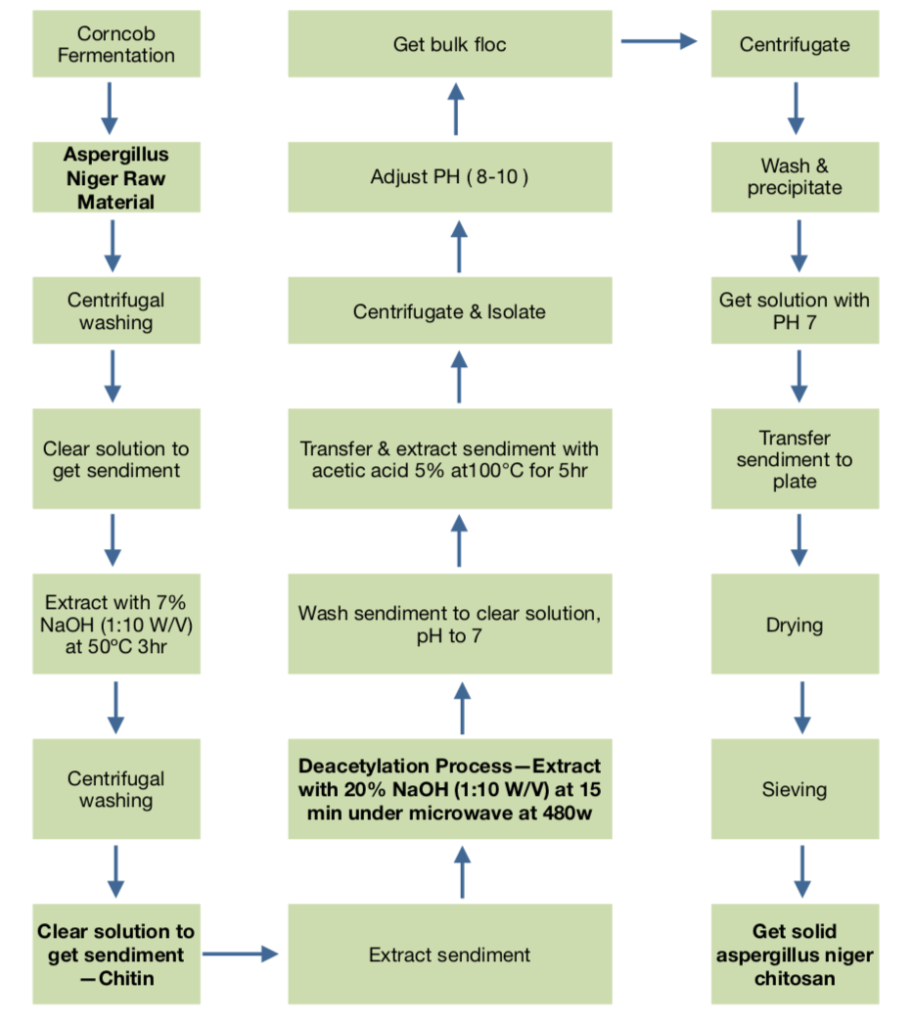
The flowchart of aspergillus niger chitosan outlines the process for extracting chitosan from Aspergillus niger, a type of fungus. Here’s a step-by-step summary of the key points:
- Starting Material: Aspergillus niger is cultured through a fermentation process using corn.
- Extraction:
- The fungal biomass undergoes a bulk flocculation.
- This is followed by centrifugation to separate the components.
- The pH of the resulting material is adjusted to alkaline conditions (pH 8-10).
- Another round of centrifugation and isolation occurs.
- The pH is adjusted back to neutral (pH 7), and the sediment is washed and precipitated.
- The sediment is then extracted with 5% acetic acid at 100°C for five hours to get the clear solution.
- It is washed again to achieve a clear solution with a neutral pH.
- Chitin Production:
- The clear solution is treated with 7% sodium hydroxide (NaOH) at a ratio of 1:10 (W/V) at 50°C for three hours.
- Centrifugal washing follows, resulting in the production of chitin as a clear solution to get the sediment.
- Deacetylation:
- The sediment undergoes the deacetylation process. It’s treated with 20% NaOH at a ratio of 1:10 (W/V) and heated in a microwave at 480W for 15 minutes.
- This step is crucial to convert chitin into chitosan by removing acetyl groups.
- Final Steps:
- The final sediment, which is now deacetylated chitin or chitosan, is extracted.
- It undergoes drying, followed by sieving to achieve the desired particle size.
- End Product: The final product is solid Aspergillus niger chitosan.
This process includes several steps involving pH adjustment, centrifugation, chemical treatments, and heating, which are critical to ensuring the purity and quality of the chitosan extracted from Aspergillus niger.
7. In summary of vegetal chitosan in hair care application
Vegetal chitosan is valued in hair care for its ability to bind moisture, reduce frizz, and enhance shine. As a film-former, it offers protection and strength to hair strands. In product formulations, it is typically used at concentrations of 0.1% to 2%, depending on the product’s intended effect. Its natural origin and biodegradability also make it an attractive component for eco-friendly hair care solutions.
Considering future functions and benefits of vegetal chitosan in hair care that could be developed and researched, we might see:
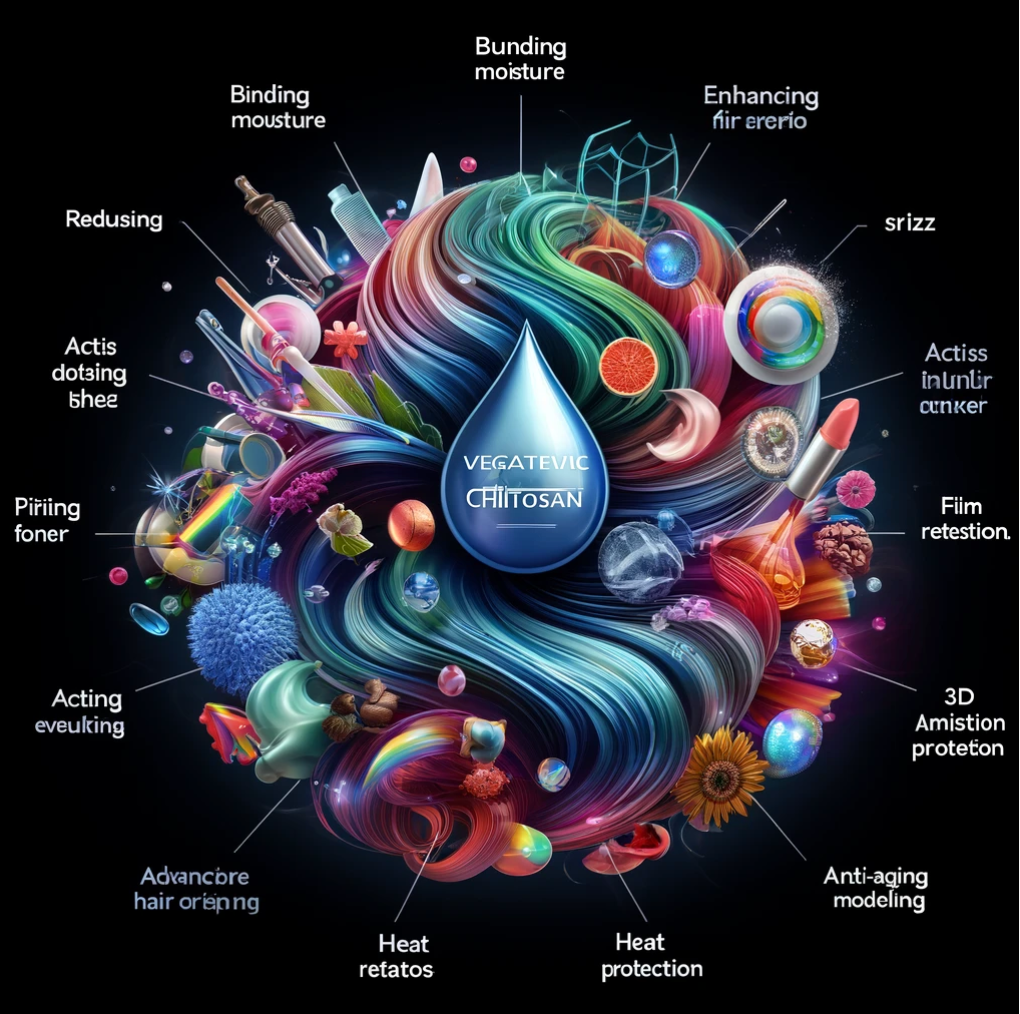
- Advanced Hair Repair: Research into how vegetal chitosan can penetrate the hair shaft to repair damage at a molecular level, beyond surface-level conditioning.
- Scalp Microbiome Support: Exploring vegetal chitosan’s prebiotic properties to support a healthy scalp microbiome, which could lead to improved hair growth and scalp health.
- Enhanced Drug Delivery: Utilizing the film-forming and bioadhesive properties of vegetal chitosan to develop targeted delivery systems for hair growth stimulants or other therapeutic agents.
- Color Retention: Investigating how chitosan can protect hair color from fading, extending the life of dyed hair through its film-forming capabilities.
- Heat Protection: Developing heat-protective hair care products using vegetal chitosan to mitigate damage from styling tools.
- Environmental Protection: Enhancing the ability of vegetal chitosan to shield hair from pollutants and UV radiation, reducing the harmful effects of environmental stressors.
- Customization and Personalization: Researching the interaction of vegetal chitosan with other natural ingredients to create tailored treatments for different hair types and concerns.
- Sustainable Production: Improving the sustainability of vegetal chitosan production to enhance its appeal as an eco-friendly ingredient.
- Anti-Aging Benefits: Studying the potential anti-aging effects of vegetal chitosan on hair, such as delaying the onset of grey hair and maintaining hair density.
- 3D Hair Follicle Modeling: Using vegetal chitosan in 3D bioprinting applications for hair follicle regeneration research and potential hair loss treatments.
These future directions represent a blend of both immediate and long-term possibilities for vegetal chitosan in hair care, leveraging its natural properties for innovative and more effective hair care solutions.

